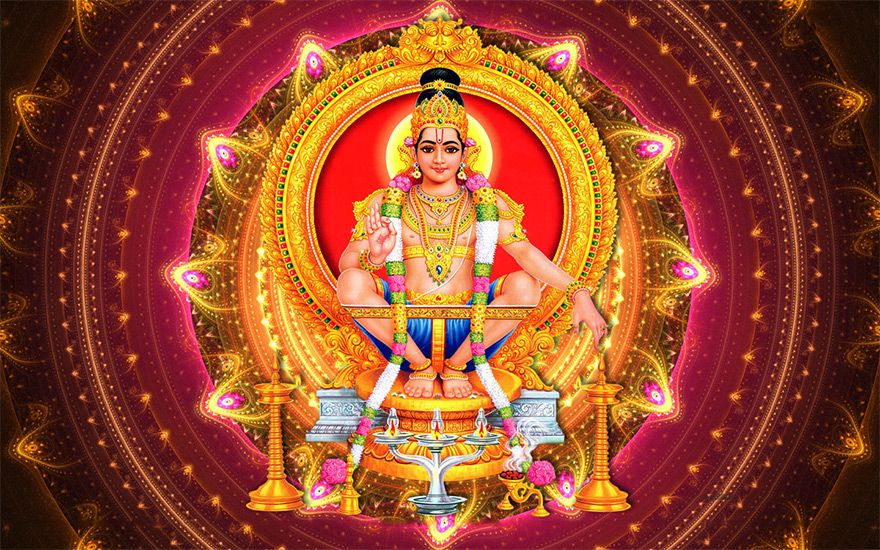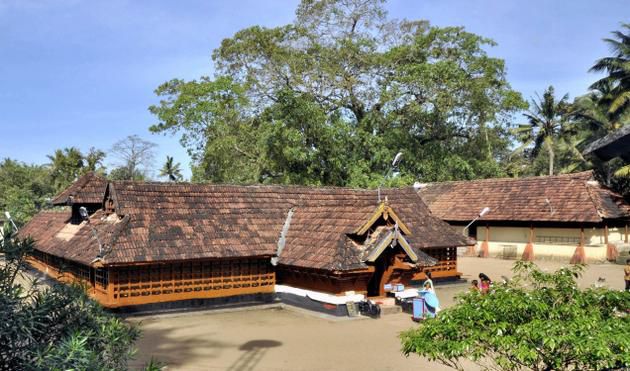No products in the cart.
Lord Ayyappa is the son of Harihara i.e. Lord Vishnu and Lord Shiva (Hari is Vishnu and Hara is Shiva or Shankaranarayana). He was born by the union of Lord Shiva and the enchantress Mohini who was an avatar of lord Vishnu. He is a Hindu deity mainly worshipped in southern India.
The Legend of Lord Ayyappan
King Rajashekara belonged to the Pandya dynasty and was the ruler of the Pandalam. He was a just and fair king and held in high esteem by his subjects. His only sorrow was that he was childless and he and his wife prayed ceaselessly to Lord Shiva for a child.
Around that time Mahishasura, a demon, did a severe tapa which forced Lord Brahma to grant him a wish that he could not be annihilated by anyone on earth. After this the demon started destroying everything and terrorizing the people. Seeing this the devas appealed to Goddess Durga who killed him in a bloody battle.
Determined to avenge the death of her brother, Mahishi, the sister of Mahishasura secured a boon from Lord Brahma that no being except the child of Lord Vishnu (Hari) & Lord Shiva (Haran) could kill her. In due course of time, Mahishi went to Devaloka and began harassing the Devas who in turn requested Lord Vishnu to help. As the boon was that nobody except the son of Lord Shiva & Vishnu could kill Mahishi, Lord Vishnu assumed the female form of Mohini and had a child with Lord Shiva.
This child was placed under the care of the childless king Rajashekhara. He found the child during a hunting trip near the banks of a river. The child was beautiful and was wearing a golden chain. As the king beheld the divine child, a sadhu appeared and instructed him to adopt the chid as his own and name him ‘Manikandan’ – the one with the golden neck. He also told the king that he would come to know of the true nature of the child when he became 12 years old.
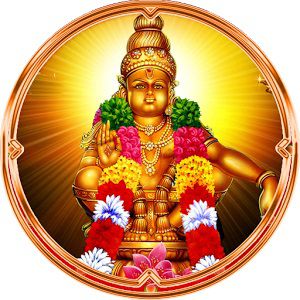 Ecstatic, Rajashekhara took Manikandan home and narrated the happenings to his queen. They took it as the blessings of Lord Shiva. Everyone rejoiced in the couple’s happiness. As Manikandan grew up he was intelligent and excelled in everything- martial arts, shastras etc. He had superhuman talents. His guru eventually concluded that he wasn’t an ordinary mortal. So when Manikandan went to receive his blessings after the completion of his studies, the guru asked him to heal the sight and speech of his son who was blind and dumb. Manikandan did that and the son was healed. Manikandan requested the miracle to not be revealed and left.
Ecstatic, Rajashekhara took Manikandan home and narrated the happenings to his queen. They took it as the blessings of Lord Shiva. Everyone rejoiced in the couple’s happiness. As Manikandan grew up he was intelligent and excelled in everything- martial arts, shastras etc. He had superhuman talents. His guru eventually concluded that he wasn’t an ordinary mortal. So when Manikandan went to receive his blessings after the completion of his studies, the guru asked him to heal the sight and speech of his son who was blind and dumb. Manikandan did that and the son was healed. Manikandan requested the miracle to not be revealed and left.
Meanwhile the Queen had given birth to a male child who was named Raja Rajan. The king sensed that this was due to the presence of Manikandan and decided to crown him as the king. Everyone rejoiced except the diwan who had harbored dreams to be the next king. And so he went to the queen and told her that it was against rules to make an adopted son the king when they had their own child. The queen fell for it. The diwan then told her to fake an illness. He then went to the physician and told him to say that the illness couldn’t be cured by anything except a tigress’s milk. He told the queen that when Maikandan went to the forest for the milk, he would either die or return as a failure which would assure the position of her son as the king. After this happened the king sent his soldiers to bring the milk but they returned unsuccessful.
Manikandan offered to help, but the king was reluctant because he was just a child. But Manikandan did not back down from his offere and eventually the king reluctantly agreed. The Panchabuthas of Lord Shiva closely followed Manikandan as he entered the forest. On the way he saw the atrocities of the demoness Mahishi in Devaloka. He was enraged and hurled Mahishi onto the earth. A bloody battle ensued and he killed her with a violent dance on the chest of Mahishi that reverberated in the earth as well as Devaloka. This dance was witnessed by Lord Shiva and Mahavishnu from a place called Kalakatti.
After this Manikandan entered the forest for tigress’ milk. Lord Shiva appeared before him and assured him of the assistance of the devas in his quest. Hence, Manikandan went to the palace sitting on Lord Devendran disguised as a tiger. Other devas followed him in the form of tigers and tigresses. As Manikandan approached the palace gates, the Sadhu from before appeared again. Manikanadan told the king that he had brought the milk. The king, who had seen through the trick of the diwan and the queen asked forgiveness from Manikanadan. He forgave the king and then said that he would have to return to Devaloka as he had accomplished the task for which he was created. He also granted the king a boon. The king told him that he wanted to construct a temple in his memory and asked him to suggest a suitable place for the temple. Manikandan aimed an arrow which fell at a place called Sabari. He told the King to build the temple in that place and then he disappeared.
Sabarimala Swami Ayyappan Temple
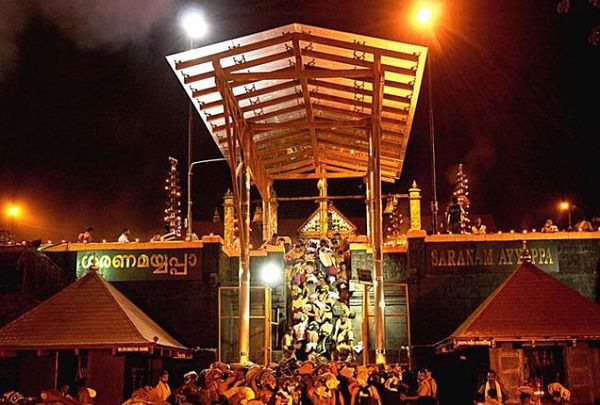
The Swami Ayyappa temple at Sabarimala was built eventually. Lord Ayyappan stated emphatically that he would grace only those devotees who offer Darshan after observing 41 days’ penance that involves strict abstinence from family desires and tastes. The devotees are expected to adhere to a way of life akin to that of a brahmachari, constantly reflecting on the goodness of life. Whilst they make their way up the steep slopes of Sabarimala, they adorn themselves with three-eyed coconut and foodstuff/Aantha Garland in their heads, as the Bhagwan did when he went to the forest to fetch tigress milk, and bathed in River Pampa raising slogans of Saranam and climb the eighteen stairs.
The Sabarimala temple also known as Sannidhanam is built on a 40 feet high plateau. The temple consists of a sanctum sanctorum with a copper-plated roof and four golden finials at the top, two mandapams, the belikalpura which houses the altar. The Pathinettu thripadikal or the 18 sacred steps is the main stairway to the temple. As per the custom followed, no pilgrim without “Irumudikkettu” can ascend the 18 sacred steps. Women between the age of 10 and 50 are not allowed in temple because Ayyappan was a brahmachari.
Every year, millions of devotees visit Sabarimala irrespective of caste or creed, with garlands and irumudis and chant paeans to Lord Ayyappa visit Sabarimala. They bathe in holy river Pampa, climb up the eighteen stairs, hoping to catch a glimpse of Lord Ayyappa.
The Jewel Casket is carried on head from the ancestral residence of the royal family of Pandalam to the Shrine on the day Ayyappa turned 12 i.e. the 14th of January. A Garuda, the Brahman kite, follows this ornaments-carrying procession, hovering about in the sky. After these ornaments are worn on the Lord the bird circles the temple in the sky three times and disappears. Excited by this sight the devotees begin to chant “Swamiye Saranam Ayyappa”. A Star never seen before in the sky appears on the day of Makarajyothi also known as Makar Sankranti before the sighting of the Jyoti. A Jyoti is seen for a little time on the hilltop showing the presence of Swami Ayyappan gracing his devotees. The devotees then accept ‘prasada’ or the Lord’s food offerings and descend the 18 steps walking backwards with their faces turned towards the Lord.
Swami Ayyappan Mantra
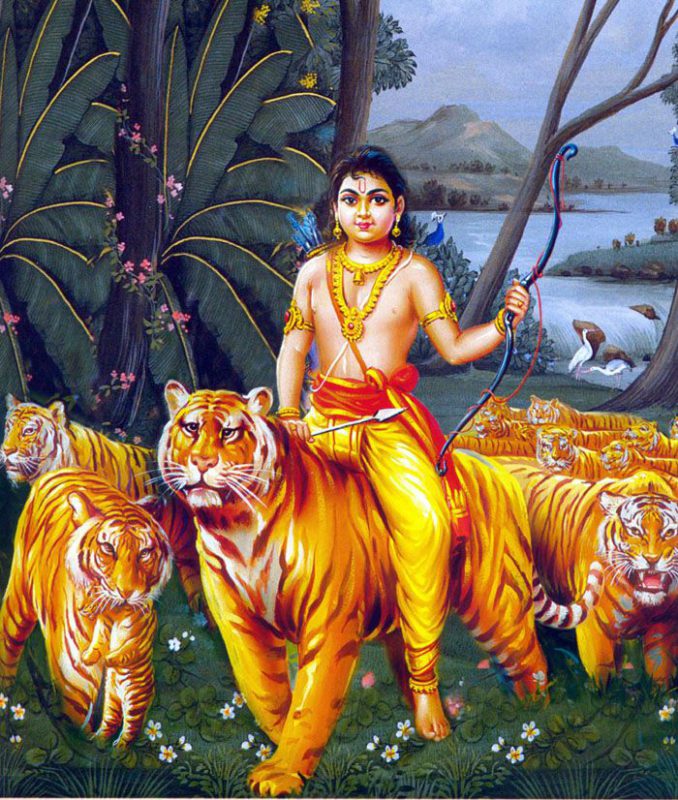
1) Ayyapaa Gayatri Mantra
Om Bootha Nathaya Vidhmahe
Bava Nandhanaya Dheemahe
Tanno Sastha Prachodayaath !
2) Prayers on Sri Dharma Sastha – Sri Ayyappa
Loka Veeram Mahaa Poojyam Sarva Rakshakaam Vibhum
Paarvathee Hr.uthayaanandham Saasthaaram Pranamaam Yaham
VipraPoojyam Visva vanthyam Vishnu Sambho Priyam Sutham
Kshipra prasaadha Niradham Saasthaaram Pranamaam Yaham
Maththamaadhanga gamanam kaarunyaamr.utha Pooritham
Sarva Vignaharam Dhe’vam Saasthaaram Pranamaam Yaham
Asmath kulesvaram dhevam Asmath Chathru Vinasanam
Asmath Ishta pradhaadharam Saasthaaram Pranamaam
Paandyesa Vamsa thilakam ke’rale’ Ke’li Vigraham
Aartha Dhraana Param Dhe’vam Saasthaaram Pranamaam Yaham
Thr.yambaga Puraadheesam Ghanaadheepa Samanvidham
Gajaarooda maham Vandhe’ Saasthaaram Pranamaam Yaham
Siva Veerya Samuthbootham Srinivaasa Thanoothbhavam
Sikivaahaanujam Vandhe’ Saasthaaram Pranamaam Yaham
Yasya Dhanvandhareer Maathaa Pithaa Dhe’vo Mahe’svarah:
Tham Saasthara maham Vandhe’ Mahaa Rogha Nivaaranam
Boothanaadha Sadhaanandha Sarvabootha dhayaabara
0Raksha Raksha Mahaabaaho Saasthre’ Thupyam Namonamah:
Aasyaama Komala Visaaladhanum Vichithram –
Varsovasaana Marunothpala Vaamahastham
Uththungarathna Makudam Kudilaagra ke’sam –
Saasthaaram Ishtavaradham Saranam Prabathye’
Important Temples of Swami Ayyappan
The Lord Ayyappa Temple, Kulathupuzha

It is located at Kulathupuzha near Thenmala in Kollam District of Kerala. It is an important shrine visited by Ayyappa devotees especially during the Mandala-Makaravilaku season. This Shasta shrine is located on the banks of Kulathu Puzha, a tributary of Kallada River, and is in the reserve forest. Kulathupuzha town is situated on the Thiruvananthapuram – Shenkottai road. Kulathupuzha is 60 km north-east of Thiruvananthapuram and 64 km east of Kollam. The deity here is Manikantan or the child form of Lord Ayyappa. The deity is popularly referred as Dharma Shasta. There are two main deities in this small temple – Lord Shiva and Shasta. Shiva is in the form of Shiva Linga and that of Shasta or Ayyappa is a stone image. The shrine also houses an elaborately carved idol of Lord Vishnu. There are also shrines of Ganesha and Devi in the compound.
Aryankavu Ayyappa Temple
It is located in Aryankavu in Kollam District. It is one among the five most important temples dedicated to Lord Ayyappa in Kerala. The shrine at Aryankav is known as Aryankavu Shastha Temple and Lord Ayyappa is depicted as a teenager (young boy) here. Ayyappa is known as Tiruaryan here and therefore the place got the name Aryankavu. Surrounded by forests, the temple is located on the Trivandrum – Tenkasi National Highway. Just like in Sabarimala, women from the age 10 to 50 are not allowed inside the Aryankavu Ayyappa Temple. The rituals and pujas followed at Aryankavu Sastha Temple is that of Tamil tradition. The sanctum sanctorum of the temple has idols of Devi, Shiva and Sastha. A young Ayyappa sits in the middle with Devi on the left side and Shiva on the right side. The festival at the temple is celebrated during the last days of the Sabarimala Mandala Kalam. The most important festivals observed here include Pandiyanmudippu, Trikalyanam and Kumbhabhishekam.
Achankoil Sastha Temple
Achankoil Shastha Temple, or the Dharmasastha Temple, is one among the five important temples dedicated to Lord Ayyappa in Kerala. Lord Ayyappa leads the Grihastha Ashrama life here – he is depicted as a family man or leads married life here. He is depicted along with his two wives – Purna and Pushkala. It is believed that the idol here was installed by Lord Parashurama. The Achankovil Sastha Temple is famous for curing poisonous snake bites. The left hand of the idol of Ayyappa at Achankoil Shastha Temple always holds ‘Chandan’ (sandalwood paste) and Thirtha (holy water). The Chandan and Thirtha are considered to have medicinal properties to cure snake bites. The most important festival here is celebrated from the first to tenth day of Malayalam month Dhanu (December – January).

